calsfoundation@cals.org
Quiltmaking
Quiltmaking is the creation of a bedspread, coverlet, or wall hanging by quilting, defined as tying or sewing three layers of material together. The art of quiltmaking was brought to Arkansas during the earliest days of settlement, and it had come to the United States from Great Britain and other western European countries. The art of quilting was probably introduced to Europe in the form of clothing worn under the armor of Turkish people, and quilting has been traced to ancient China, Egypt, and India. Exploring the Americas, most Spanish conquistadors wore quilted cotton jackets in place of armor due to the scarcity of iron. When armor was available, the quilted clothing may have been worn under it, as it was by the Turks. Quilting has also been applied to items other than clothing and blankets, such as table-runners, potholders, jewelry, and art quilts.
The earliest quilts originating from Arkansas can be dated from the nineteenth century, and the majority date to 1850 and later due to an influx in population and a greater availability of fabric. A small number of surviving Arkansas quilts have been dated around the 1830s. As in England, quiltmaking in Arkansas served a practical purpose, which was to provide warm bed coverings. Because quilts were used regularly, those from before the 1830s may simply not have survived. With frequent use and washings, the quilts likely deteriorated and were discarded or used as the batting for new quilts.
The Old State House and the Historic Arkansas Museum—both in Little Rock (Pulaski County)—have quilt collections that can be viewed in person or online. Some other collections of quilts include those held by the Rogers Historical Museum in Rogers (Benton County) and the Shiloh Museum of Ozark History in Springdale (Washington County).
Parts of a Quilt
The decorative layer is known as the quilt top. The quilt top is sometimes pieces of fabric sewn together (called piecework); however, not all quilt tops are piecework. Some are one piece of fabric, and others have appliqué or other ornamental needlework such as cross-stitch, embroidery, or a combination of stitches, as in the crazy quilt. Yo-Yo quilts include a series of rosettes sewn together. Iron-on transfers, paint, sequins and other embellishments might adorn a quilt. Quilt tops could utilize scraps of fabric from old clothes or sacks, or consist of fabric specifically bought from a retail store as quilt material. Some early pioneers might have home-spun the fabric, and many early Arkansans dyed their own fabrics.
Dyes can be used to date quilt fabrics, and possibly the quilts themselves. Quilt tops can also sometimes be dated by type. For example, pieced patchwork appears at least as far back as 1780. Whole cloth tops were prevalent in the Americas between 1750 and 1850. Chintz appliqué dates from approximately 1775 to 1865. Friendship blocks, which still enjoy popularity, began after the textile mills began producing fabric in 1840. Still popular among quilters are charm quilts (circa 1870–1950) and crazy quilts (circa 1880–1910).
Just as varied as quilt tops is the batting, which is the middle layer of the quilt, typically a soft or warm material. Some quilts have been discovered that do not contain a batting, but battings are generally included in quilt construction. The batting of quilts is believed to have included feathers, pine needles, newspapers, burlap sacks, wool, cotton, man-made materials, and even old quilts. Some early Arkansas quilters would grow their own cotton and use it as batting after it was hand carded. Winters could be harsh, and warmth was a necessity, but the pine needles, newspapers, and feathers, while probably providing warmth, did not last long.
The backing of a quilt is traditionally one whole piece of cloth complementary to the top, but materials used have included burlap sacks and tobacco bags; like the top, the backing might also be pieced with various scraps.
Modern quilt connoisseurs and quilters encourage the use of labels that tell the name(s) of the creator(s), where the quilt was created, the date the quilt was started and completed, the name of the quilt and blocks encompassed, for whom the quilt was created, the occasion for which the quilt was created, and any other pertinent information.
Tradition and Significance
Quiltmaking sometimes serves as a form of artistic expression. The making of a quilt can take long hours of preparation and labor and requires patience. In the past, quilts were often given as gifts to mark special occasions. Many quilters continue this tradition, and quilts remain embedded for many with strong personal meanings, memories, and sentiments.
The craft of quiltmaking was traditionally passed from mother to daughter, sister to sister, and friend to friend. While quilting is mostly done by women, some men create quilts. In modern times, quilting is still passed on by family members and friends, but it is also learned in quilting guilds, retail settings, churches, and conventions. In addition to face-to-face educational opportunities for learning, there are also quiltmaking television programs and video recordings.
In the 1800s, quilting frolics, bees, and parties were gatherings of women and girls at which it was customary for attendants to work together on one quilt. The quilt would be stretched on a large frame that some or all of the attendants could sit around as they stitched. At this stage in the quiltmaking process, the top, batting, and backing were all layered together, and members of the quilting frolic would work to finish the quilting of the whole so that the finished quilt could be soon used or given as a gift. Quilting frolics were social events for women, and during the day they might cook while they quilted or bring food to the event.
Because opportunities for socializing were scarce, invitations to quilting frolics were expected, and it was considered rude not to invite every able woman to a frolic. In 1849, Everand Dickinson of Izard County wrote, “It is customary here for the Neighbors to take turns in helping each other harvest. They all go with their wives and daughters and babies. The men gather the wheat while the women quilt.” A quilting frolic might be held to complete an everyday quilt, but it might also be held for special quilts such as the customary thirteen quilts, or baker’s dozen, that would go in the hope chest of a young woman who was soon to be married.
Quilting at frolics and bees would usually be done by hand. By the 1930s, sewing machines became widely available and were credited with a sudden drop in the popularity of quiltmaking. In the twenty-first century, quiltmaking has resurged in popularity, and sewing machines, embroidery machines, and long-arm quilting machines are all used in the craft of quiltmaking. Quiltmaking by hand remains popular, and some quilters today use a combination of hand and machine stitches.
The creation of a quilt sometimes involved more than one person, even if all the quilters did not work at the same time. Quilt tops were sometimes created by the donation of blocks from several different people to mark a special occasion like a wedding or retirement. The popular friendship quilts incorporated blocks in which the donors would sign their names to the blocks they donated.
Some quilts commonly used in the 1900s, due to the publication of quilt patterns in the Kansas City Star (a newspaper accessible to Arkansans), were the Dresden Plate, Grandma’s Flower Garden, Drunkard’s Path, Nine Patch, and Trip around the World.
African-American Quiltmaking
In Arkansas, African Americans’ quilts are as distinctive as those of the Anglo-Saxon tradition, though occasionally both groups used the same patterns and materials. Slave quilts are exceedingly rare anywhere (slave quilts owned by descendants of the creator are even rarer), and no recorded example made by an Arkansas slave has been found. An interesting design found in Arkansas is the Pine Cone or Pine Burr, which was also made by Americans of Anglo-Saxon descent, though from different states, and they might have called it a different name, such as Target or Bull’s Eye. Examples of the African-American Pine Cone quilt can be viewed at the Old State House. The quilts consist of concentric circles of triangular bits of fabric that pointed toward the center. The quilter would begin with a small circle of triangles and then place more and more triangles around in larger and larger circles. The resulting quilts were heavy and contained many colorful scraps. The earliest African-American quilts on record from Arkansas are dated circa 1890.
African-American quilts have been found that included older quilts as batting, and the tradition is believed to have come from a reverence for the work of the ancestor who stitched the original.
Arkansas Quilt Blocks
Some quilt blocks with Arkansas-specific names include the Arkansas Star and Arkansas Crossroads. Arkansans have also quilted maps and flags of their state. Dorris Curtis, a famous Arkansas artist who painted in a primitive style, made a quilt in the shape of the state of Arkansas, with the patches shaped into the various counties. The materials of her quilt were given to her by friends, and the quilt can be seen in the collection of the University of Central Arkansas in Conway (Faulkner County) or in the artist’s book Come Walk with Me: The Art of Dorris Curtis (2004).
Continuing the Tradition
In modern times, the quilting frolic has been replaced by quilting guilds such as the Q.U.I.L.T. (Quilters United In Learning Together) Guild of Northwest Arkansas and the Arkansas Quilters Guild of Little Rock, which meet monthly and provide members with continuing education opportunities as well as a place to meet socially and share quilts in progress and completed projects. Guilds or clubs such as these can be found across the state, and some guilds hold conventions annually. Annual conventions might also include contests, giving the quilters a chance to compete for prizes and recognition. Some guilds, like the one in Morrow (Washington County), still communally finish quilts together. The Arkansas state and county fairs also help continue interest in quiltmaking by providing a place for quilters to gain recognition for their work. County extension offices and programs were once and still remain a resource for information on quiltmaking, as well as offering a place to hold meetings and workshops.
The War Eagle Craft Fair, started by county extension agent Blanche Hanks Elliott in 1954, offers a place for handcrafted items, including quilts, to be placed for sale. Made-in-Arkansas quilts are sold, with some of the proceeds used to generate funds for special organizations or events. Just as the quiltmaking can be communal, so can the sale itself. In Altus (Franklin County), every Thanksgiving marks a public celebration with a quilt auction and raffle. While some quilts are sold for charities around the state, other quilts are donated for worthy causes, including children’s charities, homeless citizens, and military service members.
One of the most notable quilts of the twentieth and twenty-first century is the NAMES Project Memorial Quilt, which serves as a memorial to people who have died of AIDS. Parts of the quilt are regularly displayed in Arkansas, usually on the lawn of the William J. Clinton Presidential Center and Park.
For additional information:
“Arkansas Quilt Guilds.” QuiltGuilds.com. http://www.quiltguilds.com/arkansas.htm (accessed February 5, 2024).
Arkansas Quilters Guild, Inc. Arkansas Quilts: Arkansas Warmth. Paducah, KY: American Quilter’s Society, 1988.
Arkansas Quilters Guild, Inc. Arkansas Quilters Guild. http://www.arkansasquiltersguild.org/ (accessed February 5, 2024).
Benberry, Cuesta. A Piece of My Soul: Quilts by Black Arkansans. Fayetteville: University of Arkansas Press, 2000.
Bennett, Swannee, and William B. Worthen. Arkansas Made. Vol. 1: Furniture, Quilts, Silver, Pottery, Firearms. Fayetteville: University of Arkansas Press, 1991.
Better Homes and Gardens. 501 Quilt Blocks: A Treasury of Patterns for Patchwork & Applique. Des Moines, IA: Better Homes and Gardens Books, 1996.
Blanche Hanks Elliott Papers. Special Collections. University of Arkansas Libraries, Fayetteville, Arkansas.
Curtis, Dorris. Come Walk With Me: The Art of Dorris Curtis. Fayetteville: University of Arkansas Press, 2004.
Fellone, Frank. “A Stitched Community.” Arkansas Democrat-Gazette, May 2, 2022, pp. 1D, 6D. Online at https://www.arkansasonline.com/news/2022/may/02/arkansas-quilters-craft-and-donate-comforting/ (accessed February 5, 2024).
Fons, Marianne, and Liz Porter. Quilters Complete Guide. Birmingham, AL: Oxmoor House, Inc., 1998.
Fons, Marianne, and Liz Porter. Quilts from America’s Heartland: Step-by-Step Directions for 35 Traditional Quilts. Emmaus, PA: Rodale Press, 1994.
Hartney, Nancy. “Quilts: Pieced Tales of Comfort from Washington County History.” Flashback 69 (Fall 2019): 133–142.
Heidingsfelder, Sharon. Quilts. Little Rock: Cooperative Extension Service, University of Arkansas, 1986.
Ledbetter, Richard. “Family History Entered in Quilt.” Pine Bluff Commercial, October 28, 2021, pp. 1, 2. Online at https://www.arkansasonline.com/news/2021/oct/28/family-history-entered-in-quilt/ (accessed February 5, 2024).
Luster, Michael. Stitches in Time: A Legacy of Ozark Quilts. Rogers, AR: Rogers Historical Museum, 1986.
Q.U.I.L.T. Guild of NW Arkansas. http://quiltguildnwa.edublogs.org/ (accessed February 5, 2024).
Safford, Carleton L., and Robert Bishop. America’s Quilts and Coverlets. New York: E. P. Dutton & Co., Inc., 1972.
Pamela Lochridge Kirkpatrick
Fayetteville, Arkansas
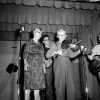 Folklore and Folklife
Folklore and Folklife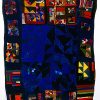 Tompkins, Rosie Lee
Tompkins, Rosie Lee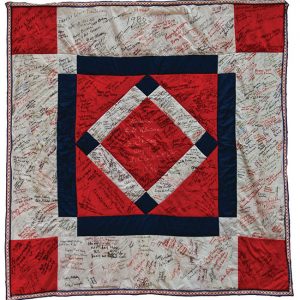 Clinton Quilt
Clinton Quilt 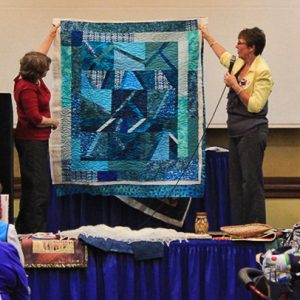 Contemporary Quilt
Contemporary Quilt  Hand Quilting
Hand Quilting 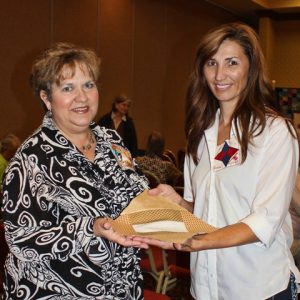 Quilt Block Presentation
Quilt Block Presentation  Quilt Top
Quilt Top  Quilt Backing
Quilt Backing 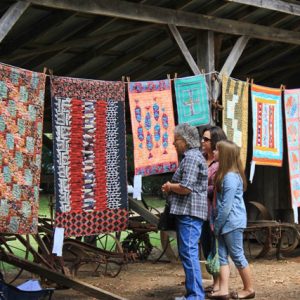 Shiloh Quilt Fair
Shiloh Quilt Fair 



Comments
No comments on this entry yet.